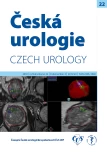Andrological factor-the influence of age on the success of assisted reproduction?
Authors:
Viera Belušáková; Michaela Grossová; Lenka Rybánska; Jozef Války
Authors‘ workplace:
Iscare, Klinika reprodukčnej medicíny, gynekológie a urológie, Bratislava
Published in:
Ces Urol 2018; 22(4): 266-274
Category:
Original Articles
Overview
The study describes a retrospective analysis of spermiogram pathology from assisted reproduction perspective. We analyze the age range of patients undergoing the in vitro fertilization cycle at our workplace over the last 10 years, the effect of age on spermiogram pathology, and the influence of age on the success rate of assisted reproduction cycles. Centres of assisted reproduction are continually trying to increase the success of in vitro fertilization cycles. Attention is now focusing on a more detailed analysis of the influence of male factor on the success of assisted reproduction treatment.
Design:
The retrospective analysis of the andrological factor in accordance with the age effects on spermiogram parameters and the success rate of assisted reproduction cycles.
Methods:
We compared the age of patients undergoing assisted reproduction cycles from the years 2007 and 2017. We evaluated the individual sperm parameters of our patients in accordance with their age. The total sperm concentration, motility and sperm morphology as well as the influence of age on sperm DNA fragmentation were analyzed. Because we needed to minimize the influence of female factor, we made a restriction in the consecutive analysis and selected only respondents from the oocyte donation program. We evaluated the influence of age of males on the success of IVF-ICSI method in couples undergoing assisted reproduction.
Results:
Age seems to be a determining factor of the quality of spermiogram in the group of normospermics evaluated by classical spermiogram parameters. The decrease of normospermics in accordance with the age is significant. On the contrary, combinations of the pathologies in spermiogram increase with age. When assessing individual parameters such as total sperm concentration, motility and sperm morphology, there is no significant difference. The conclusions in the analysis of the success of IVF‑ICSI method are controversial, especially with the selection of respondents. However, the difference in the success of the donor program can be attributed to the reparative ability of the „young“ donor oocyte.
KEY WORDS
Andrological factor, assisted reproduction, success of IVF.
Sources
1. Levine H, Jørgensen N, Martino‑Andrade A, et al. Temporal trends in sperm count: a systematic review and meta‑regression analysis. Hum Reprod Update 2017; 23(6): 646–659.
2. Kumar N, Singh AK. Trends of male factor infertility, an important cause of infertility: a review of literature. J Gynecol Obstet Hum Reprod 2015; 8(4): 191–196.
3. Williamson R. Properties of rapidly labelled deoxyribonucleic acid fragments isolated from the cytoplasm of primary cultures of embryonic mouse liver cell. JMB 1970; 51(1): 157–160.
4. Paul C, Murray A, Spears N, et al. A single, mild, transient scrotal heat stress causes DNA damage, subfertility and impairs formation of blastocysts in mice. Reproduction 2008; 136(1): 73-84.
5. Peluso G, Palmieri A, Cozza PP, et al. The study of spermatic DNA fragmentation and sperm motility in infertile subjects. Arch Ital Urol Androl 2013; 85(1): 8-13.
6. Molina RI, Martini AC, Tissera A, et al. Semen quality and aging: analysis of 9.168 samples in Cordoba. Argentina. Arch Esp Urol. 2010; 63(3): 214–222.
7. Jørgensen N, Joensen UN, Jensen TK, et al. Human semen quality in the new millennium: a prospective cross‑sectional population‑based study of 4 867 men. BMJ Open. 2012; 2(4): e000990.
8. Axelsson J, Rylander L, Rignell‑Hydbom A, Giwercman A. No secular trend over the last decade in sperm counts among Swedish men from the general population. Hum Reprod 201; 26(5): 1012–1016.
9. Baudoard C. Ménézo Y, Panteix G, Ravanat JL, et al. Determination of new types of DNA lesions in human sperm. Zygote 2008; 16 (1): 9–13.
10. Singh NP, Muller CH, Berger RE. The effects of male age on sperm DNA damage in healthy non‑smokers. Fertil Steril 2003; 80(6): 1420–1430
11. Winkle T, et al. The correlation between male age, sperm quality and sperm DNA fragmentation in 320 Men) attending a fertility center. J Assist Reprod Genet 2009; 26 (1): 41–46.
12. Agarwal A, Gupta S, Du Plessis S, et al. Abstinence time and its impact on basic and advanced semen parameters. Urology 2016; 94 : 102–110
13. Bashir M, Ayad G, Van der Horst S, du Plessis S. Short abstinence: a potential strategy for the improvement of sperm quality. Middle East Fertil Soc J 2018; 23 (1): 37–43
14. Ménézo Y, Dale B, Cohen M. DNA damage and repair in human oocytes and embryos: a review. Zygote 2010; 18(4): 357–365.
Labels
Paediatric urologist Nephrology UrologyArticle was published in
Czech Urology

2018 Issue 4
Most read in this issue
- Andrological factor-the influence of age on the success of assisted reproduction?
- Correlation of invasive methods and urine cytology in detection of urothelial neoplasms: one centre early experience with application of The Paris System for Reporting Urinary Cytology
- Current status of urine cytology: what should the urologist know?
- New options of intravesical instillation therapy in bladder cancer
